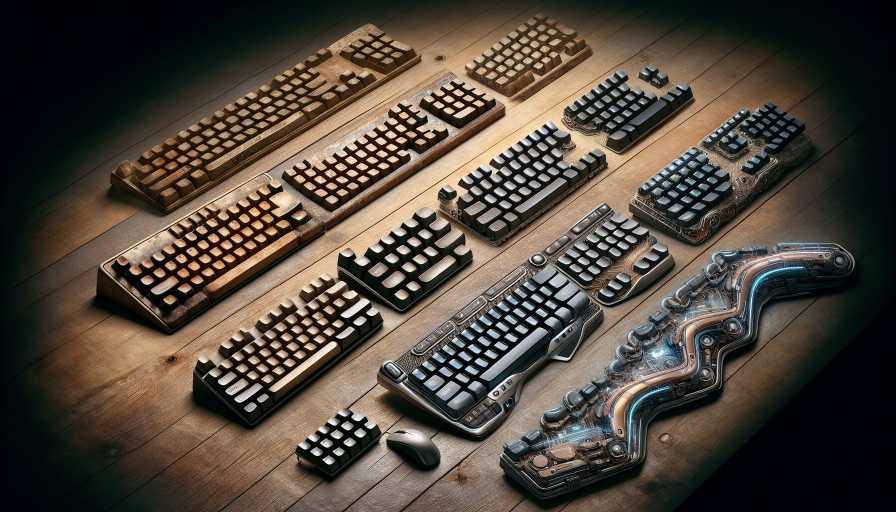# The Evolution of Typing Keyboards: From QWERTY to Ergonomic Designs
Welcome to TypeTest.io, the ultimate destination for all your typing test needs. Whether you're a seasoned typist or just getting started, we're here to help you improve your typing speed and accuracy. But have you ever wondered about the evolution of typing keyboards? How did the QWERTY layout become the standard, and what advancements have been made to improve typing efficiency and comfort? Let's take a journey through the history of typing keyboards, from the old-school QWERTY to the modern ergonomic designs.
# The QWERTY Inception and its Dominance
In the early days of typewriters, typists were facing a unique problem: the mechanical arms carrying the letters would often collide and get stuck if they were pressed too quickly in succession. To mitigate this issue, Christopher Latham Sholes, the inventor of the typewriter, devised the QWERTY layout in 1873. The QWERTY design rearranged the keys to minimize these collisions and allow typists to type at a faster pace without constantly jamming the machine.
While the QWERTY layout proved successful in its initial purpose, it had some unintended consequences. Most notably, it wasn't designed with efficiency or ergonomics in mind. The keys were arranged in alphabetical order, which meant frequently used letters were spread apart. This arrangement led to more finger movement and slower typing speeds.
# The Need for Speed: The Dvorak Simplified Keyboard
As typewriters evolved into computers, programmers and researchers started to question the efficiency of the QWERTY layout. In 1936, Dr. August Dvorak and his brother-in-law, Dr. Franz Wagner, proposed an alternative keyboard layout known as the Dvorak Simplified Keyboard (DSK). The DSK aimed to optimize typing speed and reduce finger movement by placing the most commonly used keys on the home row, where the fingers naturally rest.
Studies have shown that the Dvorak layout can significantly improve typing speed and reduce fatigue. However, despite its advantages, the QWERTY layout had become so ubiquitous that making the switch to Dvorak was an uphill battle. Most typists were already familiar with QWERTY and reluctant to relearn a new layout. As a result, the Dvorak layout remains a niche choice for a small group of dedicated enthusiasts.
# Ergonomics Takes Center Stage: From Split Keyboards to Adjustable Angles
As technology advanced and our understanding of ergonomics improved, manufacturers started to explore new keyboard designs that focused on comfort and user-friendly ergonomics. One notable evolution was the introduction of split keyboards. Split keyboards feature a split in the middle, allowing the typist to position their hands in a more natural, relaxed position. This design helps mitigate the strain on the wrists and can reduce the risk of developing repetitive strain injuries (RSIs).
Furthermore, many modern keyboards offer adjustable angles and tenting options. By allowing users to adjust the keyboard's angle and elevation, these keyboards cater to individual preferences and provide a more personalized typing experience. Ergonomic keyboards are designed to minimize discomfort and strain, making them a popular choice among typists who prioritize their well-being and long-term typing efficiency.
# Measuring Typing Speed: The Birth of WPM (Words Per Minute)
As typing became an essential skill in the digital age, the need arose for a standardized way to measure typing speed. Thus, the concept of Words Per Minute (WPM) was born. WPM is a universal metric used to gauge a typist's speed and efficiency in terms of words typed within a minute. It serves as a benchmark to track progress and compare typing skills across the board.
TypeTest.io not only offers a convenient platform to take typing tests but also provides accurate WPM measurements to help you monitor your improvement over time. By regularly practicing with our typing tests, you can boost your WPM and become a more proficient typist, regardless of the keyboard layout you prefer.
# Conclusion: Striking the Perfect Balance
The world of typing keyboards has come a long way since the invention of the QWERTY layout. From its inception to the rise of the Dvorak layout and the focus on ergonomics, the evolution of keyboards has been driven by the pursuit of faster, more efficient, and comfortable typing experiences. While the QWERTY layout remains the standard, alternative layouts and ergonomic designs have given typists the freedom to choose what works best for them.
At TypeTest.io, we understand the importance of finding the perfect keyboard setup that suits your typing style and needs. Whether you're a fan of the classic QWERTY or exploring the benefits of alternative layouts, our typing tests and resources are here to support your journey towards improved typing speed and accuracy.
So, why wait? Take a typing test on TypeTest.io today, discover your WPM, and unlock your true typing potential. Happy typing!
